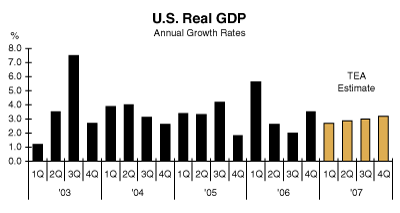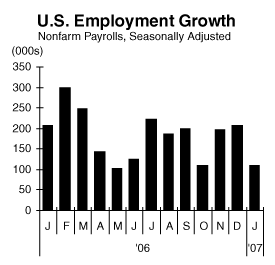|
February 7, 2007
Big Ball of Wax
Written by Jeff Thredgold, CSP, President, Thredgold Economic Associates
Economic data came in waves in recent days as new reports regarding U.S. economic growth, Federal Reserve policy, and employment were released. When you mashed it all together, this big ball of wax suggested the American economy is just fine…the Fed will likely remain on hold for a long time to come…and U.S. job growth continues to be impressive.
The U.S. Economy
Numerous noisy naysayers (say that three times quickly) spouting imminent U.S. economic recession have had their heads handed to them in recent days as new economic data reports of an American economy that is doing quite well. Our prior forecast of reasonable U.S. economic growth has not changed. We did then and do now expect the U.S. economy to grow at a 2.5%-3.0% real (after inflation) annual rate in 2007, with the risk being that growth could actually be stronger. 
The American economy grew at an inflation-adjusted 3.5% annual pace during the October-December quarter, above the recent consensus forecast of 3.0% real growth. Despite recognized weakness in home construction and auto production, the fourth quarter growth pace was the strongest since the first quarter of 2006. Note: Just to keep us on our toes, the fourth quarter GDP estimate will be revised each of the next two months.
Strength? The American economy actually grew at a slightly stronger pace in 2006 (3.4% after inflation) than it did in 2005 (3.2%). Consistency? The American economy grew at a real average annual pace of 3.3% during the past four years. Size? The American economy is now a $13.5 trillion ($13,500,000,000,000) behemoth, roughly three times that of runner-up Japan.
In addition, inflation pressures were muted during the fourth quarter. A measure of prices tied to consumer spending (the personal consumption expenditures index, or PCE deflator) dropped 0.8% during the past 12 months, the first decline since 1961.
The Federal Reserve’s most favored inflation measure, the core PCE (which excludes food and energy costs), rose 2.1% during the past 12 months. The rate remains barely above the Fed’s presumed annual target range of 1.0%-2.0%.
The Federal Reserve
As expected by everyone and their mother, the Federal Reserve remained on the monetary sidelines following its January 30/31 Federal Open Market Committee (FOMC) meeting. The Fed has now remained on the sidelines for seven months, following 17 consecutive monetary tightening moves between June 2004 and June 2006.
The FOMC noted in its widely-followed statement that “readings on core inflation have improved modestly in recent months, and inflation pressures seem likely to moderate over time.” The FOMC also seemed comfortable with economic growth developments, noting that “recent indicators have suggested somewhat firmer economic growth, and some tentative signs of stabilization have appeared in the housing market.” The statement continued, “Overall, the economy seems likely to expand at a moderate pace over coming quarters.”
After some early stumbles as Fed Chair, Ben Bernanke has performed well in what many consider the second most powerful job on the planet. The FOMC obviously feels vindicated with its decision last June to move to the sidelines. Given the current favorable mix of moderate U.S. economic growth and declining inflation pressures, the Fed could well stay on the sidelines until the latter part of the year.
U.S. Employment
There was something for everyone in the January employment report released on February 2. Economic critics could point to the less-than-expected 111,000 net rise in employment in January, below the 150,000 expected job rise. 
Economic cheerleaders could point to the 81,000 upward revisions to employment gains of the two prior months. Economic optimists could also point to the more than 800,000 upward revision to employment gains for the 12-month period ending March 2006, the largest “benchmark revision” to prior data in a generation.
Revisions are made annually as more complete employment data is gleaned from tax records and unemployment tax information. Note: economists had been informed of this upcoming revision last October.
The nation’s unemployment rate rose slightly to 4.6% in January, versus 4.5% in the two prior months. By comparison, October’s 4.4% rate was the lowest in nearly six years.
More moderate growth in wages was seen as good news at the Fed, less so for workers. The average hourly wage rose 0.2% (up three cents) to $17.09 in January. The 4.0% rise over the past 12 months compares to a 2.5% rise in consumer inflation during calendar year 2006, providing for solid growth in real wages.
Employment weakness continued in the nation’s manufacturing sector, with a loss of 16,000 jobs during the month. The construction sector added 22,000 net new jobs during January, with gains in commercial real estate activity more than offsetting losses in residential construction.
Service-providing employment saw solid gains during the month, with a net rise of 104,000 jobs. The education & health services sector added another 31,000 net new jobs in January, while professional & business services added 25,000 net new jobs. The government sector added 14,000 jobs during the month, while retail trade added 4,000 jobs.
Bottom Line
Solid U.S. economic growth with minimal inflation…historically low short-term and long-term interest rates, with the Fed on hold…solid employment gains with low unemployment and rising real wages…all combining to boost stock prices…
…not a bad combination

Another Promise
Three weeks ago, we told you about the “Kalamazoo Promise” where wealthy individuals in Kalamazoo, Michigan are paying the college tuition of students who graduate from the local school system. A similar promise is now being offered to students in El Dorado, Arkansas by locally-based Murphy Oil Corporation.
The company is pledging $50 million over the next 20 years for this scholarship program. One distinction from the Kalamazoo program is that the scholarship, though capped at the highest Arkansas public tuition rate, can also be used out of state.
Kudos to Murphy Oil for making a difference.

“Tea”sers
Only in America…
…do banks leave both doors to the vault open and then chain the pens to the counters
…do people order double cheeseburgers, large fries, and a diet coke
…can a pizza get to your house faster than an ambulance
|

